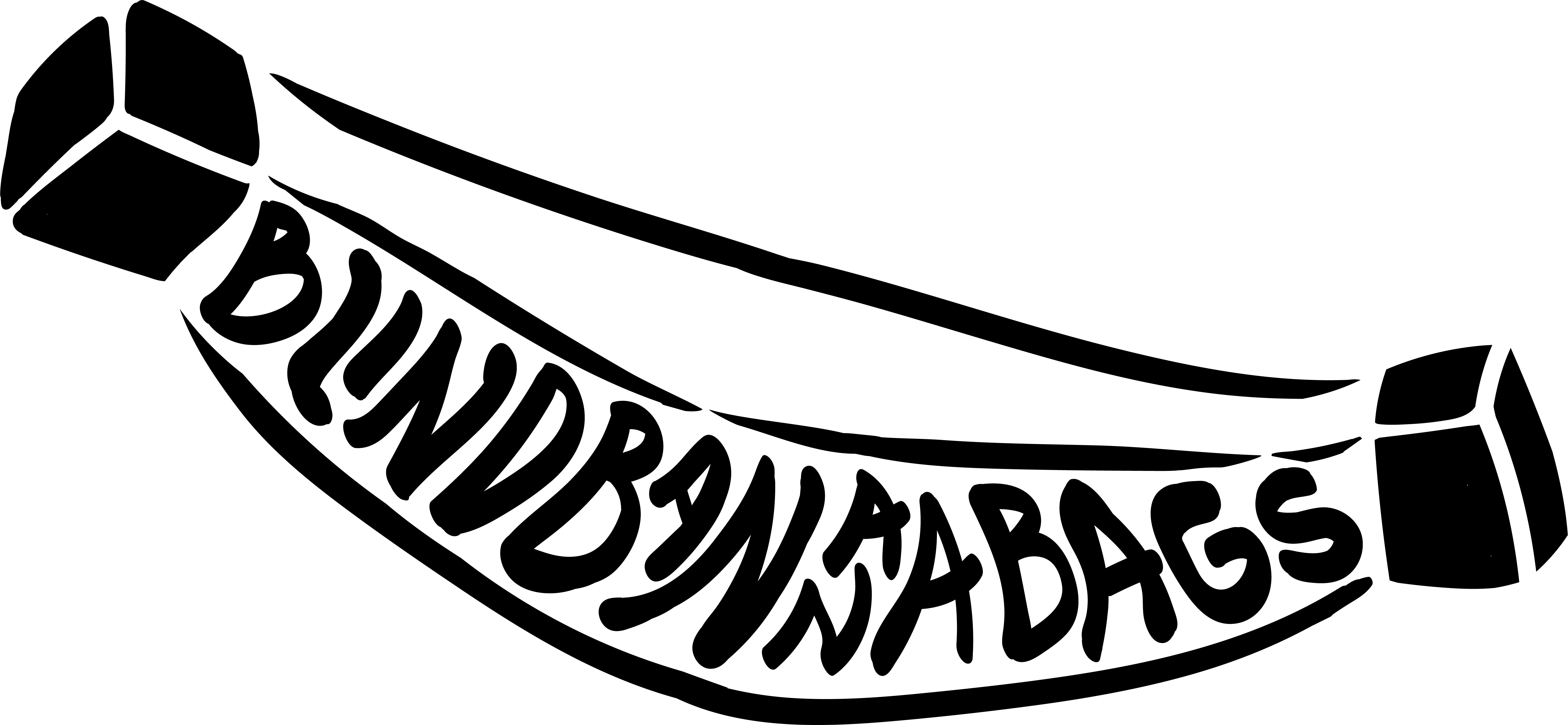Pack guide
How much are you planning on carrying?
The range of packs I offer differ in the amount of support they provide. Choosing something to suit what you’ll be carrying is paramount. Going frameless can be tempting because of the lower weight, but overload it by more than a few kg and your tired shoulders quickly put a damper on your trip. Going for a pack with excess structure, support and padding won’t be a nearly as punishing an experience as you’ll simply be carrying a few hundred grams more.
If it’s your first ultralight pack, my recommendation is to err on the side of comfort and pick a pack that’ll keep you within the load ranges below for at least 95% of your trips. Going above on the first day when you’re fully stocked on both food and water won’t be the end of the world.
Sizing and Fit
The correct amount of support is important, but it won’t do you much good if the pack doesn’t fit you. In order to achieve a truly comfortable pack, I offer several sizes and shapes – 4 back lengths, 3 hip sizes, 2 hip belts shapes and 2 shoulder strap shapes. Offering every pack in 48 sizes is far off from economically viable for most manufacturers but since I make every pack from the ground up anyway and there’s nobody to stop me, here we are…

Back length
It’s measured from your C7 vertebrae to your illiac crest. It’s best to use a measuring tape or string to follow the curvature of your back. Wearing a pair of trousers at the height of your illiac crest makes it eaiser to do solo.
Short 40-44cm | Medium 44,5-48cm | Long 48,5-52cm | X-long 52,5-56cm
If you prefer to wear your hip belt above your the illiac crest, you need to subtract length accordingly for an optimal fit.
If you’re right inbetween sizes, you should generally size down. The only exception is when you’ll be using a webbing hip belt most of the time with Plantain.
If you require a shorter or longer pack, I can still make it for you. Contact me.
Hip belt
Measure around your hip at the height of your illiac crest. The sizes are an optimal fit range where you get an appropriate amount of padding wrap around your hips. They can be adjusted beyond so there’s no need to worry if you’re at the edge of a size.
Small 72-84cm | Medium 85-99cm | Large 100-125cm
The most appropriate hip belt shape can be determined by measuring 5cm above the illiac crest. If this measurement is smaller, a curved belt will wrap and rest better on your hips. If it is larger, a straight belt is better.
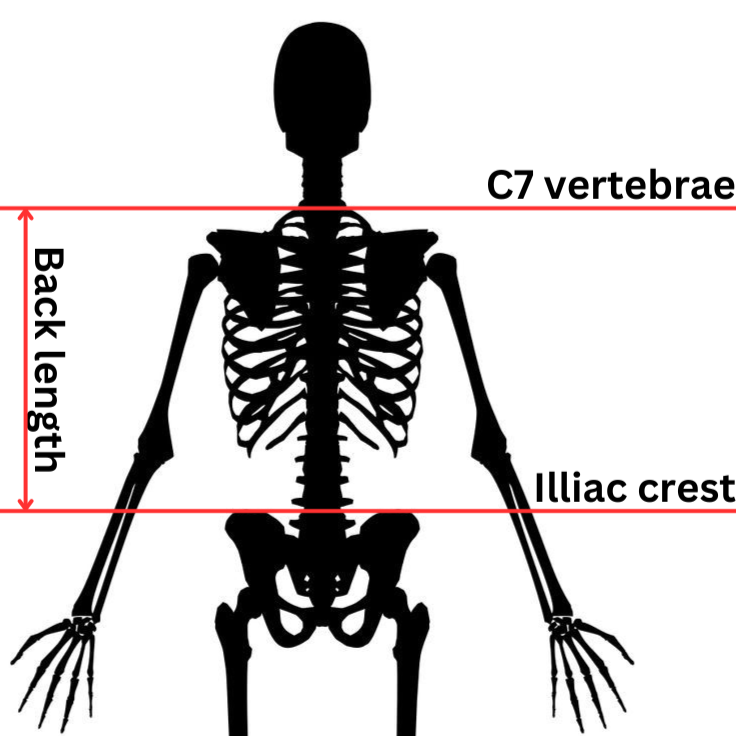
English
Dansk
Shoulder straps
Here a measurement or a simple female/male dichotomy is not enough as the shapes are more complex. Below is a list of prioritized factors that can help determine which one fits best. The chest and shoulders are more important than height.
S-shaped shoulder straps are better if you…
1. have a curvy or sensitive chest
2. have flatter shoulders
3. are shorter than about 180cm or use Short/Medium back length
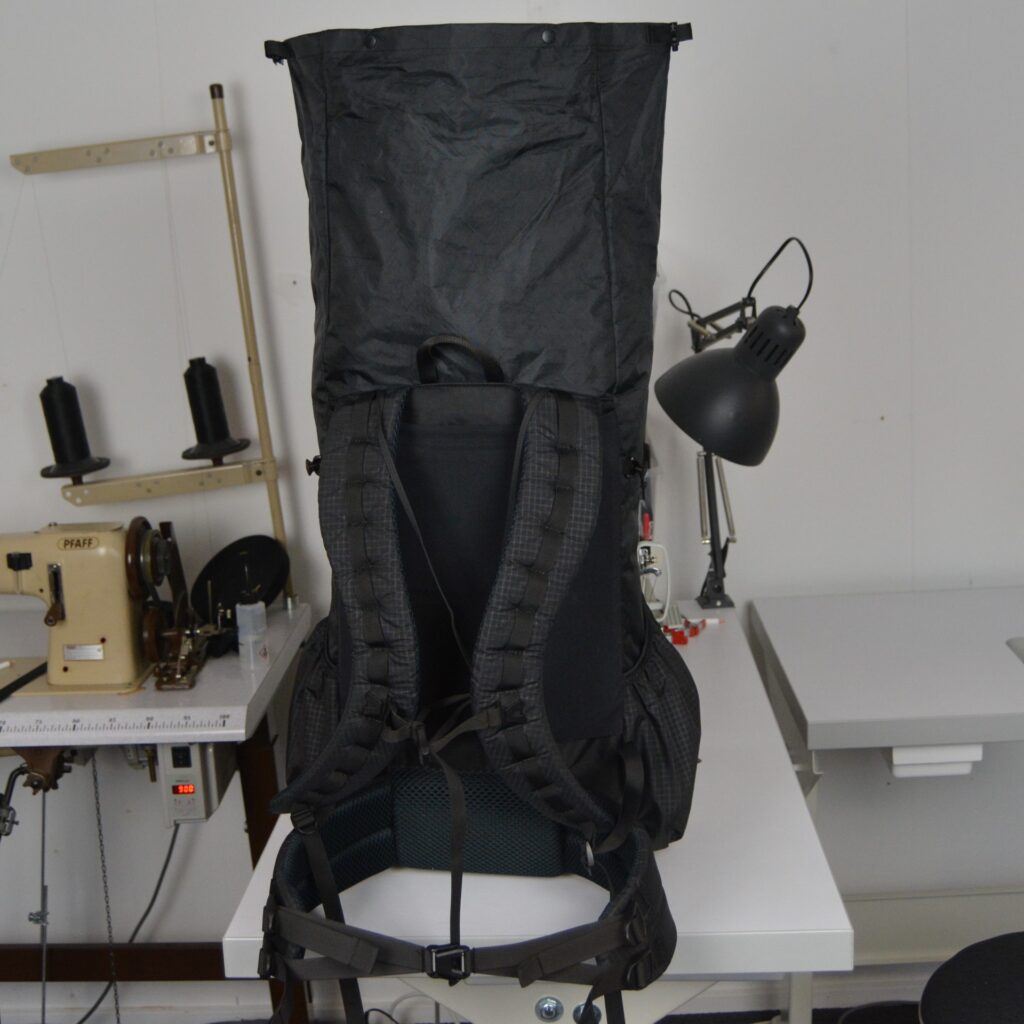
J-shaped shoulder straps are better if you…
1. have a flatter chest
2. have a wide neck
3. have angled shoulders
4. are taller than about 175cm or use Long/X-long back length
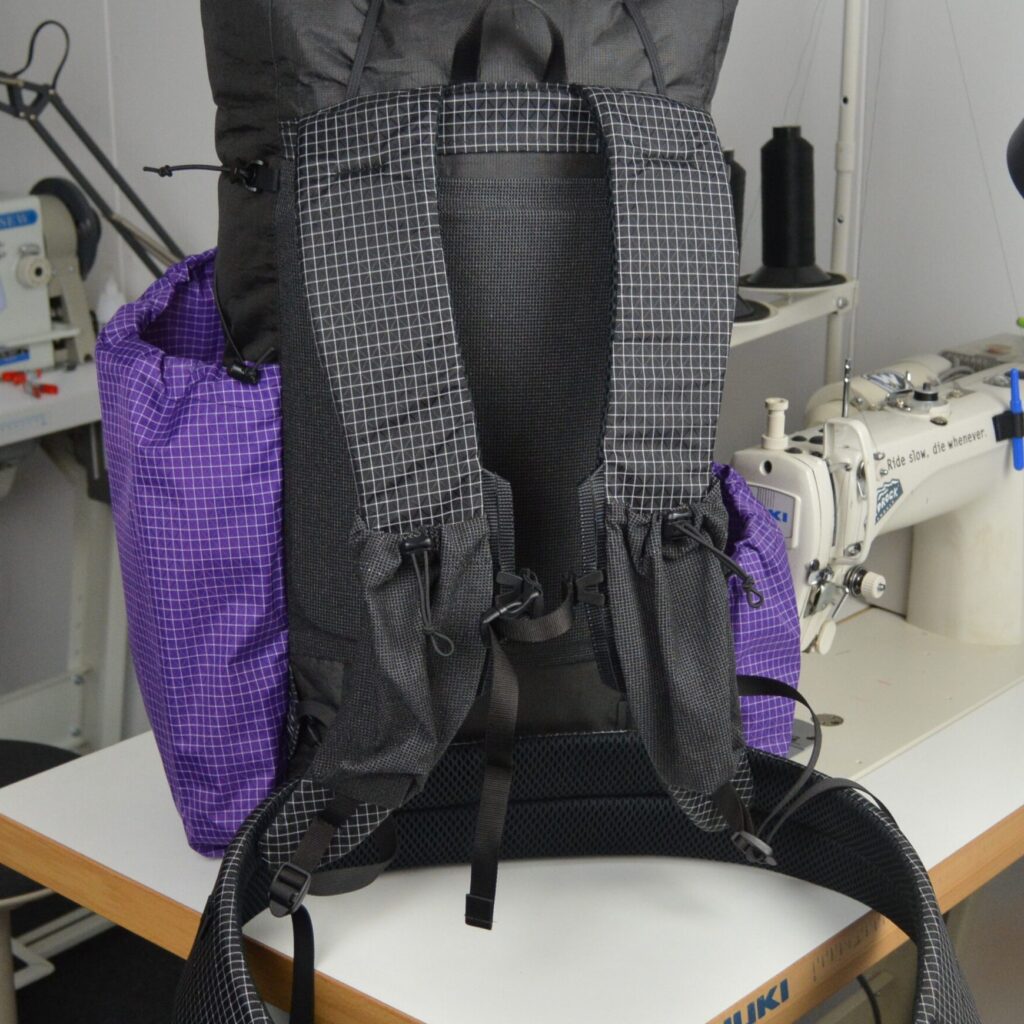
The standard Plantain comes with a wide version of the J-shaped straps to spread out the load on your shoulders. These are also available for Morado Light. The standard Morado comes with S-shaped straps in short and medium while the long and x-long come with J-shaped straps.
What fabric should you choose?
EPLX – lightweight option for on-trail hiking
EPX – long-lasting option for on-trail hiking
UltraTX – long-lasting option for off-trail hiking
If you want more nuance and specifications, read further below.
EPLX
The lightest all-polyester waterproof fabric. Great for on-trail hiking when weight matters. It will handle soft goods well but is not the best choice if you pack sharp items unprotected internally. Can be repaired with seam tape.
200 denier polyester face, 45° polyester Cross-ply and waterproof 0,5mm polyester RUV-film. Polyester components are 100% recycled.
Weight: 146 gsm
EPLX600
600 denier polyester face, 45° polyester Cross-ply and waterproof 0,5mm polyester RUV-film. Polyester components are 100% recycled.
Weight: 304gsm
EPX
Solid 3-layer fabric with long waterproof lifespan. Great for on-trail hiking too. There’s many colors to choose from and the backing means you can pack pretty much whatever you’d like.
C0 DWR, 200 denier polyester face with 45° Cross-ply, and 70 denier polyester ripstop backing.
Weight: 200gsm
Ultra200TX
The best of both worlds – the abrasion resistance of Ultra with the increased stability and prolonged waterproof lifespan of a 3-layer laminate. The ultimate choice for long lasting frame packs!
200 denier Ultra face, 45° polyester Cross-ply and 70 denier polyester ripstop backing.
Weight: 200gsm
For most pockets waterproofing is not a concern and therefor non-laminated fabrics are used. They’re lighter, more supple and cheaper too. In terms of technical properties Ultragrid does come out on top but there’s not much in the difference. In other words, pick the color you’d like!
A more detailed comparison
Properties like waterproofness, abrasion resistance, tensile strength, and tear resistance can be measured in a standardized way. Therefore, they tend to be the most common way fabrics are compared. However, they only hint at the longevity and performance of a fabric, as real-world usage differs wildly to the singular properties tested in isolation. Below is a chart of fabrics I offer with some common alternatives ranked by weight:
| Fabric | Weight (g/m2) | Abrasion (ASTM 3884 cycles) | Tear strength warp/weft avg (N) | Waterproof | Recycled components |
| DCFH50 | 102 | 500 | 191 | Yes | 0% |
| Ultra200 | 119 | 4400 | 516 | Yes | 40% |
| Ultragrid | 132 | 1100 | na | No | 90% |
| DCFH150 | 170 | 500 | 245 | Yes | 0% |
| RBC400 | 178 | 3000* | na | No | 90% |
| Ultrastretch | 186 | 3000 | na | No | 0% |
| EPX200 | 200 | 500 | 115 | Yes | 100% |
| VX21 | 210 | 500 | 93 | Yes | 0% |
| Ultra200TX | 210 | 4400 | 516 | Yes | 60% |
| Ultra400TX | 244 | 8800 | 689 | Yes | 55% |
| EPX400 | 304 | 3000 | 159 | Yes | 100% |
| EPX400HH | 310 | 15000 | 159 | Yes | 48% |
*based on fabrics with the same face
What can the numbers be used for?
In my experience, face fabric denier correlates better with real-world performance than most other metrics. Fabrics that score low for their face denier generally perform better in real world conditions than standardized tests would suggest. The opposite is also true.
Example: The ~200 denier polyester face of EPX/EPLX holds up better than the 50 denier polyester face of DCFH50, even though they score the same in abrasion testing. Ultra200 doesn’t perform an order of magnitude better than DCFH50, but it is still significantly stronger.
A note on Ultra
The amazing properties of UHMWPE used in Ultra are not without caveats, as it is very slippery and has a low-energy surface, meaning it makes for an unstable weave that is hard to bond. This is why Ultra has 1/3 polyester in the face. It stabilizes the weave and allows stronger bonding of the film, which further stabilizes the fabric as a whole. The film is not just for waterproofing, but also an integral part of the fabric. In real world conditions the film deteriorates and the integrity of the fabric gets compromised. I’ve had a much higher rate of fabric failure with UItra because of this and have discontinued the fabric as a result. EPLX performs just as good or even better at a lower price.
The new UltraX features a stabilizing X-grid and a thicker film improving the longevity. I’ve considered it but ultimately decided to stick with UltraTX as it has performed great and is worth the added weight for frame packs especially.
The outside is not everything
While all the main fabrics are waterproof to over 200psi (140000mm HH!), packs made from them are not equal in waterproofing, especially over time.
As I’m lucky enough to have a dad that develops sports clothing and tests fabric as his day job, I enlisted his help to test the internal abrasion resistance of my most used fabrics. He uses a Martindale tester, which can be loaded with a coarse woolen pad as an abrasive. This is a milder abrasive than the ASTM 3884 test in the chart above but perhaps more relevant as it more closely mimics the wear inside a pack. You can see more here.
Normally testing goes up to 50.000 cycles, which is the gold standard for workwear. The samples are pictured after 90.000 cycles. This was the point where you could see discernible wear on all but one sample.
EPLX (upper left) faired the best with no visible wear.
Ultra (upper right) had wear through the film only at the small creases created where the sample is gripped.
UltraTX (lower right) had very little wear, only visible on the cross-ply.
EPX (lower left) had wear all the way through the woven layer at multiple points along the cross-ply .
Both EPLX and Ultra have the same film. This version of UltraTX has a smoother weave internally than EPX. While only a sample size of 1 it’s always great to test things as this went contrary to my own intuition.
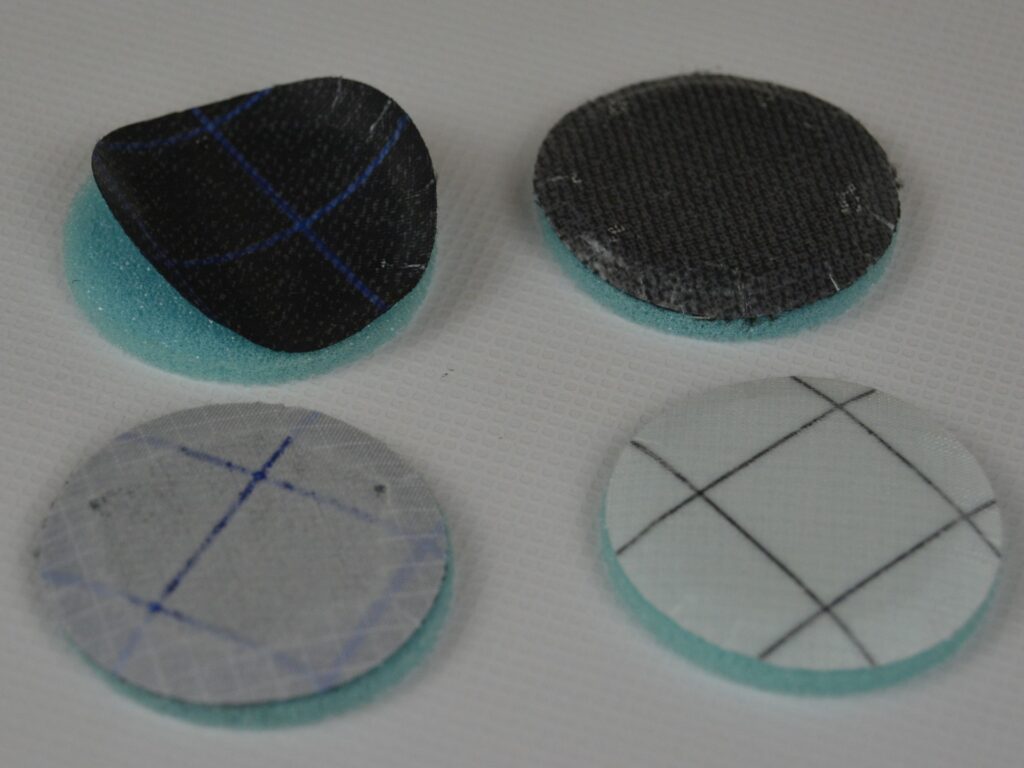
The smoother film surfaces seem to handle textile abrasion very well. Packing your drybags, tent and clothing appears to not be an issue.
The woven layers showed more wear from this particular test, but do better in every other test that I can think of. The naked film is much more susceptible to scratching and puncturing. Once it is even slightly compromised, it becomes more susceptible to wear and tear as witnessed on the Ultra sample.
Practically all types of standardized testing show only a single attribute in isolation. In the real world multiple types of wear compound and create many failure modes. The main failure mode is not always external abrasion. For laminates, fabric stability matters greatly to prevent delamination. Using less slippery yarns like polyester, incorporating a crossply that runs on the bias and having a large proportion of woven content create a more stable fabric.
Stability: EPX > UltraTX > EPLX > Ultra(x)
In short, a pack made from EPX is likely to last longer than one made from Ultra, unless subjected to certain types of abrasion that Ultra excels at. Ultra has accounted for about 3/4 of all reports of fabric failure on my packs, with all of them being tied to delamination. I’ve therefore discontinued the fabric as it increases the cost with no practical benefit for the vast majority of users.
